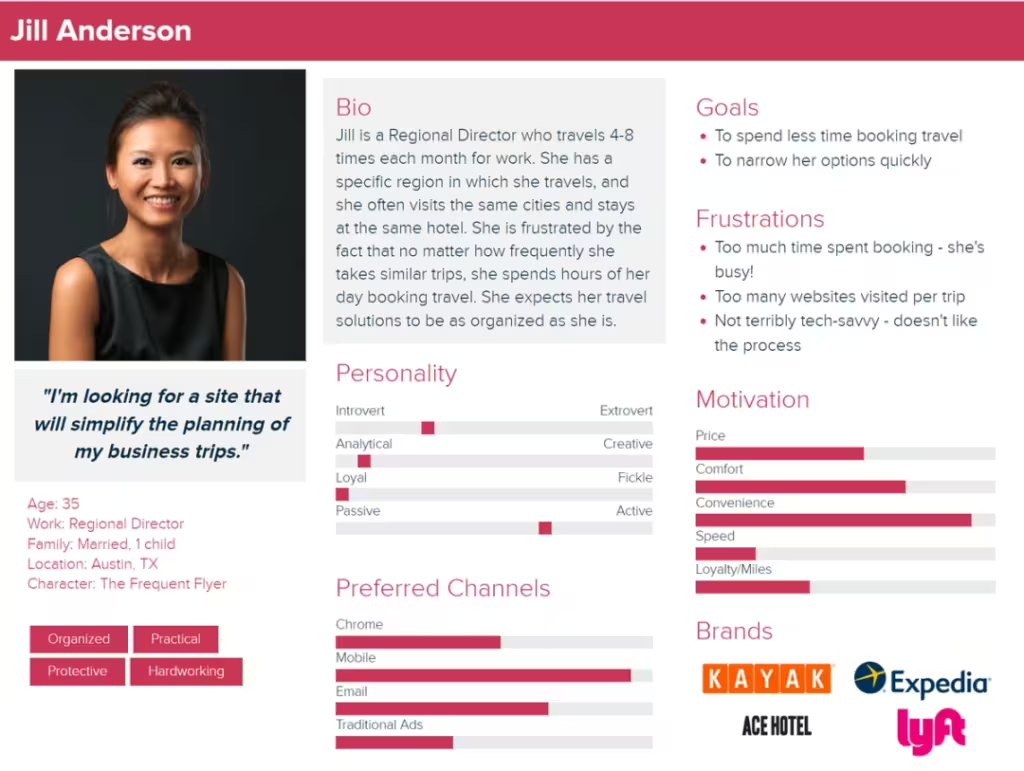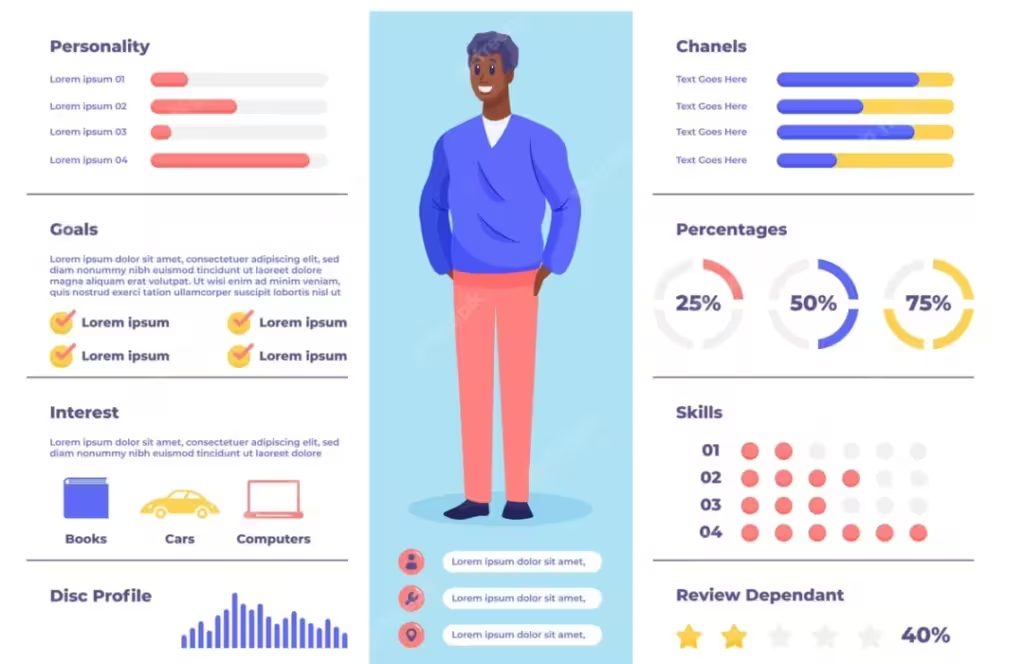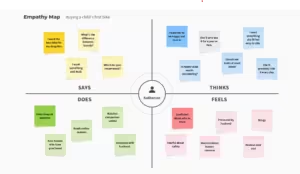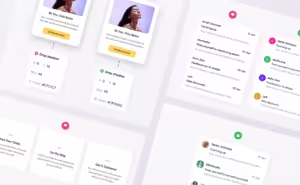Unlock audience insights with user personas —a guide to creating targeted experiences and products rooted in real user needs and behaviors.

User personas are essential for UX designers, allowing them to craft user-centered design solutions. By understanding these personas, UX teams can tailor interfaces that resonate with their target audience while achieving key business objectives.
In this article, we will explore what user personas are, how they differ from user archetypes, and their significance in UX design. Additionally, we’ll provide a step-by-step guide for creating effective user personas.
What Is a User Persona in UX Design?
User personas are fictional representations of your ideal customers, crafted by UX designers to gain insight into user needs and characteristics. This process begins with user research, helping you understand what users require from your product and their unique goals and behaviors.
Building a user persona is vital for effective marketing, as it represents either an existing or ideal customer. By engaging with users and analyzing demographic and psychographic data, you can create realistic personas that encapsulate user goals, needs, values, and motivations. These personas inform your marketing strategies and ensure you target the right audience.

User Personas in UX Design: Why They Matter
User personas are crucial in the design process as they enable teams to adopt a user-centered approach. By utilizing personas, designers can better understand the needs and preferences of their target audience, ensuring that the final product resonates with users.
Build Loyalty
To create a product that truly benefits its users, the design team must cultivate strong empathy. Personas play a vital role in fostering this understanding, allowing creators to develop deeper insights and compassion for users, which ultimately leads to more meaningful and engaging experiences.

Creating fictitious user personas helps designers grasp what target users value and desire, enabling them to objectively align their designs with real needs. Visualizing a persona allows designers to anticipate potential customer expectations for the product or service. By empathizing with these fictional characters, they can focus on delivering high-quality experiences that resonate with users.
It’s crucial for designers to recognize users as real individuals and understand their personas. The more they engage with users as people, the easier it becomes to consider all aspects when designing tailored solutions. Identifying with the target user base simplifies the creation of effective and functional designs.
Share the Expectations
When collaborating within multidisciplinary teams, it’s essential for all members to align on design decisions. User personas effectively encapsulate critical user data in an easily understandable format, ensuring that everyone is on the same page regarding expectations. This alignment fosters more efficient results throughout the design process.
Ease the Decision-Making Process
User personas empower designers with the insights needed to develop a robust product strategy and conduct usability testing. By gaining a deeper understanding of user behaviors and needs, product teams can clearly identify the target audience and prioritize essential features from the user’s perspective. For example, feature requests can be ranked based on how well they meet the requirements of the primary user persona(s).
Creating User Personas for UX Design: A Step-by-Step Guide
Creating user personas is an integral part of the UX design thinking process. Here is a step-by-step guide on how to create a user persona.

Identify Your Target User Demographic
Who are you designing for?
Begin by determining the demographics of your target user persona, including factors like age, gender, and location.
Personal Background
User personas encompass various details, such as age, gender, ethnicity, education level, and persona group (e.g., undergraduate journalist). They also shed light on family status, whether users are single, married with children, or widowed.
For example, consider Jill: she is a 35-year-old woman from Austin, Texas, who is married and has one child. This demographic information helps inform design decisions tailored to her needs and lifestyle.

Professional Background
The professional background of a user persona includes details such as occupation, salary bracket, and work history.
For our Jill persona, she works as a Regional Director.
Gather User Data
What are they like?
Exploring psychographics delves deeper into your users’ attitudes, interests, motivations, and pain points. By developing a comprehensive profile with these insights, you gain a better understanding of why individuals use your product or service.
In Jill’s case, her situation is clear: she frequently travels for work, and her primary pain point is spending too much time organizing each trip. Jill struggles with technology and needs a website or app that can simplify her travel planning and improve her overall efficiency.
Create an End Goal
Why do they need your product?
The end goal represents the driving force that motivates users and encourages them to take action. It answers the question of what users hope to achieve when using your product, serving as a central focal point for your personas. Understanding these end goals is crucial for grasping user preferences and needs, allowing you to design solutions that effectively meet their demands.
By clearly identifying the end goals, you can ensure that your product aligns with users’ aspirations, providing them with meaningful benefits and enhancing their overall experience.

Jill is organized and prefers using one website to plan her trips, wanting all her travel needs in one place. If designing a travel helper for her, focus on integrating ticket bookings, hotel reservations, and transfer arrangements into a single platform. This approach simplifies her planning process, saves time, and enhances her overall travel experience.
Find Scenarios of Interaction
How do they use your product?
User personas gain value when linked to relevant scenarios that illustrate their interactions with your product. Creating hypothetical situations helps demonstrate how the user persona would engage with the product to achieve their goals.

When designers pair personas with scenarios, they gain a clearer understanding of the primary user flows. This insight enables them to compile requirements that guide the development of design solutions tailored to those needs. To effectively capture this perspective, scenarios should be articulated at a high level, outlining potential use cases.
For instance, if Jill finds your travel helper product convenient, she might use it 4-8 times a month. By addressing all her pain points, the product could foster her loyalty, ensuring that she continues to rely on it for her travel planning needs.
Where to Find a User Persona Template
A user persona helps designers gain insights into user needs and preferences. So, where can you find user persona templates?
You can start by searching online! Numerous user persona templates are available for free download on websites like Template.net, HubSpot, and UXPin. Many of these templates include helpful instruction manuals, making it easy to create user personas quickly and efficiently. Utilizing these resources can streamline your persona development process and enhance your design efforts.

Another excellent option is to use a user persona creation tool like Xtensio. These tools simplify the persona-building process by providing interactive forms that allow users to quickly input information about their customers and target user groups.
Once your user personas are created, they serve as valuable reference points for making user-centric design decisions. They help you understand user behaviors and preferences, enabling you to craft the best possible user experience. If you’re seeking user persona templates, these resources should help you get started!
Conclusion
Personas are invaluable tools for UX designers, enabling them to tailor user experiences to better align with user needs and preferences. By following the outlined steps, UX teams can effectively create user personas that inform design decisions and provide critical insights into user behavior. With these personas, UX teams can develop meaningful experiences that resonate with their target audience, ultimately enhancing overall user satisfaction.




